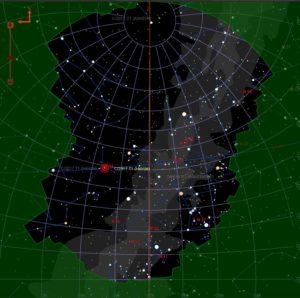This comet was discovered by Ari Heinze of the University of Hawai’i using their ATLAS system. He came across the 18th magnitude object on the 2nd of October.
The 12 frames that make up the animation were taken the evening of the 25th of December. Each frame is a 300 second exposure for a total of 1 hour of movement. Just visible is a hint of a curve in the tail. As is usual for my images, north is to the right and east is towards the top.
| C/2017 T1 (Heinze) is quickly traversing the constellation Cancer. It is currently between the orbits of the Earth and Mars and is passing up through the plane of the solar system. It will pass closest to the Sun (perihelion) on Feb. 21st but come closest to the Earth on the 4th of January. |
Calculations for the comet’s brightness predict it will be brightest viewed from the Earth on the 6th of January. If it gets as bright as predicted (Mag. 8.8) it will be visible in moderately sized binoculars or small telescopes. However, a comet’s response to the Sun’s energy is very unpredictable and thus brightness predictions are very unreliable.
